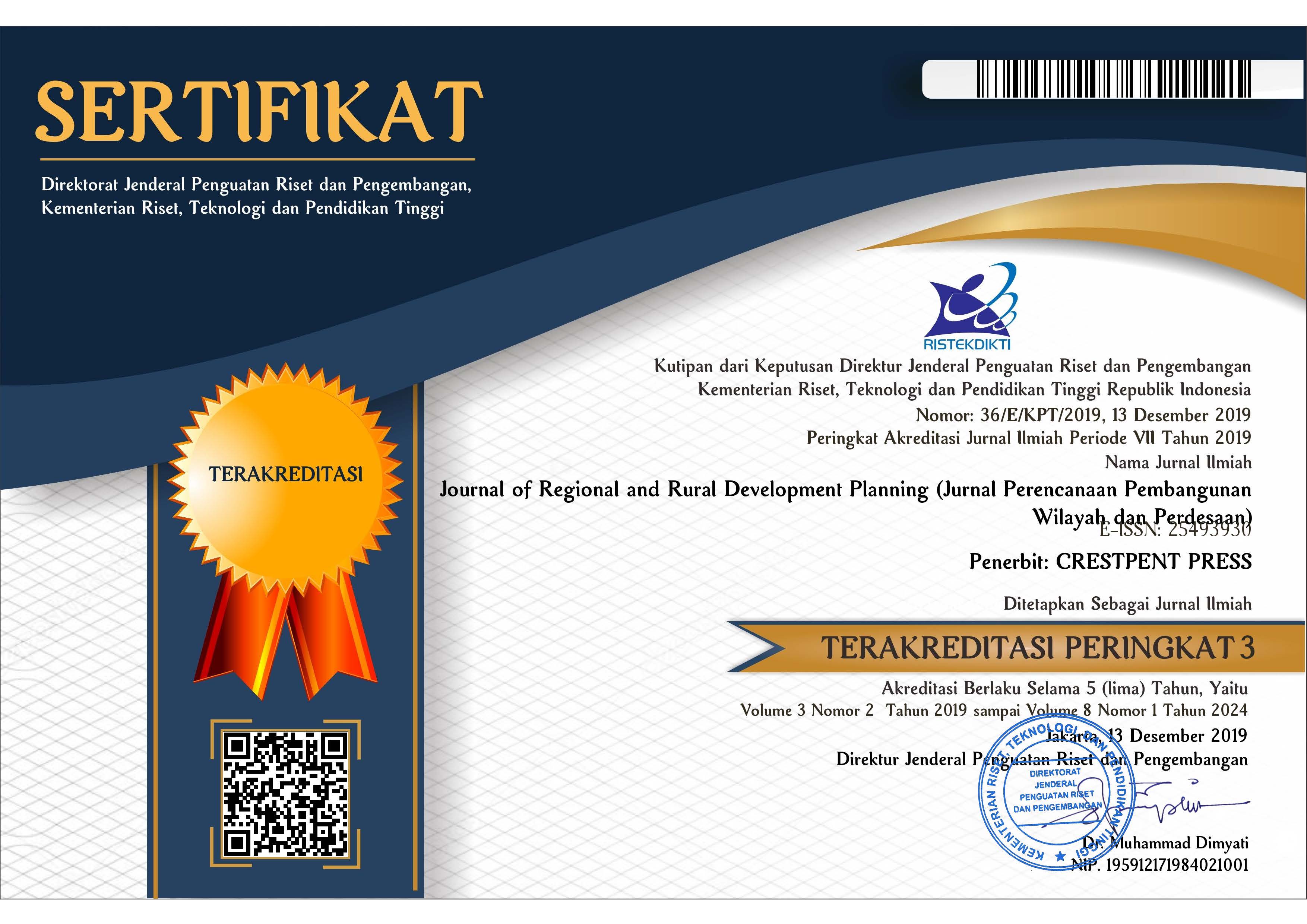Dampak Investasi Pariwisata terhadap Fungsi Permukiman di Ubud Bali: Transformasi Keruangan, Sosial dan Ekonomi
Abstract
The entry of tourism to Bali because it has a stunning natural beauty is no exception Ubud. Tourism provides many changes. Based on local sources, as well as the results of in-depth interviews with Ubud community leaders, the initial entry of tourism was because Ubud has an interesting culture. In addition, the initial capital attracts tourists to come to Ubud through its social values, invites tourists to participate in social activities, provides opportunities for tourists to become part of Ubud itself. This causes the development of tourism to increase, and encourages people to rent out their houses which we usually call homestays. Seeing this opportunity, investors began to offer funds to develop residential areas for local communities. However, the increase in tourism, of course, will affect the arrangement of settlements in Ubud. In view of this, the research aims to analyze the transformations that arise and provide an overview of changes in settlements in Ubud. The phenomena found in the field that investment has an impact on space, economy and social. This study uses a qualitative method with a phenomenological approach with data collection by field observations, in-depth interviews, and field analysis. The results of the study, which are in the form of macro and micro mapping images of the changes that occur, are expected to be able to provide a picture of changes in the functioning that occur in the Ubud Area in a spatial, socio-cultural, and economic manner properly.
References
Adinugroho, G. (2017). Hubungan Perkembangan Wisata terhadap Ekonomi Wilayah di Gunung Kidul Selatan. Journal of Regional and Rural Development Planning, 1(1), 16-27. https://doi.org/10.29244/jp2wd.2017.1.1.16-27.
Anggi, M., Pramitasari, D., & Marcillia, S. R. (2020). Citra Ubud Bali Berdasarkan Peta Kognisi Masyarakat. Langkau Betang: Jurnal Arsitektur, 7(1), 25-41. doi:http://dx.doi.org/10.26418/lantang.v7i1.34859.
Badan Koordinasi Penanaman Modal. (2020). Ini Negara Dengan Investasi Pariwisata Terbanyak Di Indonesia. Badan Koordinasi Penanaman Modal.
Badan Pusat Statistik. (2020). Kecamatan Ubud Dalam Angka 2020.
Budiharjo, R. (2013). Konsep Arsitektur Bali Aplikasinya Pada Bangunan Puri. NALARs, 12(1):17–42.
Couteau, J. (2013). Ubud: From The Origins to 19201. Jurnal Kajian Bali (Journal Of Bali Studies), 3(1), 1-32. Retrieved from https://ojs.unud.ac.id/index.php/kajianbali/article/view/15694.
Ernawati, N. M., Sudarmini, N. M., & Sukmawati, N. M. R. (2018). Impacts Of Tourism In Ubud Bali Indonesia: A Community-Based Tourism Perspective. Journal Of Physics: Conference Series 953(1), 1-9.
Febrian, A. W., & Suresti, Y. (2020). Pengelolaan Wisata Kampung Blekok Sebagai Upaya Peningkatan Ekonomi Masyarakat Berbasis Community Based Tourism Kabupaten Situbondo. Jurnal Administrasi Bisnis, 9(2), 139-148. https://doi.org/10.14710/jab.v9i2.25308
Gunawan, I. (2014). Metode Penelitian Kualitatif: Teori Dan Praktik. Jakarta: Bumi Aksara.
Hartawan, I. P. (2021). Pola Persebaran Hotel Resort Di Kawasan Pariwisata Ubud. Jurnal Anala 9(1).
Jayantiari, I. (2017). Eksistensi Tanah Adat Di Bali Dan Problematika Hukum Dalam Pengembangan Investasi. Kertha Patrika, 39(2), 108-199. doi:10.24843/KP.2017.v39.i02.p03
Kalpikawati, I. A., Pinaria, N.W.C., & Febrianto, I.G.A. (2020). Identification Of Homestay In Ubud Tourism Area And Peliatan Village Based On Asean Homestay Standard. Proceedings of the 1st Padjadjaran Communication Conference Series, PCCS 2019, 9 October 2019. Bandung,
Landra, P. T. C. (2018). Hukum Investasi dalam Industrialisasi Kepariwisataan Bali. Jurnal Magister Hukum Udayana (Udayana Master Law Journal), 7(1), 100-121. doi:10.24843/JMHU.2018.v07.i01.p09
Lianto, F., Priyomarsono, N. W., Nuramin, L., & Wiratno, B. (2021). Ensuring Genius Loci Based On Spatial Experiences Of Three Resorts In Ubud, Bali, Indonesia. Isvs E-Journal 8(1), 47-63.
Macrae, G. (2005). Negara Ubud: The Theatre-State In Twenty-First-Century Bali. History And Anthropology, 16(4):393–413.
Maulana, Muhammad Sahidin Rizal. (2017). Perananan Homestay Dalam Pengembangan Pariwisata Berkelanjutan Di Ubud. Ekp 13(3).
Meikassandra, P., Prabawa, I., & Mertha, I. (2020). Wellness Tourism In Ubud. “A Qualitative Approach To Study The Aspects Of Wellness Tourism Development”. Journal of Business on Hospitality and Tourism, 6(1), 79-93. doi:http://dx.doi.org/10.22334/jbhost.v6i1.191
Miartha, I. W. (2021). Pariwisata Ubud dalam Teologi Hindu (Manawa Dharma Sastra). Pariwisata Budaya: Jurnal Ilmiah Agama Dan Budaya, 2(2), 32–41. https://doi.org/10.25078/pariwisata.v2i2.55
Miswanto, S. (2018). Dampak Pembangunan Industri Pariwisata Terhadap Alih Fungsi Lahan (Studi Tentang Kehidupan Sosial Budaya Masyarakat Desa Teluk Bakau, Kecamatan Gunung Kijang, Kabupaten Bintan, Kepulauan Riau). Jurnal Nasional Pariwisata 10(1).
Moleong, L. J. (2010). Metodologi Penelitian Kualitatif. Bandung : PT Remaja Rosdakarya
Moleong, L J. (2019). Metodologi Penelitian Kualitatif Edisi Revisi. Bandung : Remaja Rosdakarya. Pt. Remaja Rosda Karya.
Musianto, L. S. (2002). Perbedaan Pendekatan Kuantitatif Dengan Pendekatan Kualitatif Dalam Metode Penelitian. Jurnal Manajemen dan Kewirausahaan, 4(2), 123-136.
Narottama, N., & Moniaga, N. (2021). Perkembangan dan Interaksi Modal Ekspatriat Berbasis Tourism Area Life Cycle di Ubud. Jurnal Master Pariwisata (JUMPA), , 690 - 722. doi:10.24843/JUMPA.2021.v07.i02.p16
Pinaria, C., Kalpikawati, I. A., & Febrianto, I. G. A. (2021). Karakteristik Wisatawan Yang Menginap Di Homestay Dan Persepsi Wisatawan Mengenai Ubud Sebagai Destinasi Wisata. Jurnal Kepariwisataan, 20(2), 86–91. https://doi.org/10.52352/jpar.v20i2.456
Pitanatri, P. D. S., & Pitana, I. G. (2019). Challenging The Giants: Factors Contributing To Local Homestay Competitiveness In Ubud Bali. Journal Of Social Sciences Research, 5(3), 796–802.
Pradana, G. Y. K., & Arcana, K. T. P. (2020). Hasil Pengelolaan Homestay Bercorak Budaya Ditengah Pengaruh Perkembangan Trend Millennial Di Sektor Pariwisata, Jurnal Ilmiah Hospitality Management, 11(1), 1-14. doi: 10.22334/jihm.v11i1.172.
Pradana, G. Y. K., & Arcana, K.T.P. (2020). Balinese Traditional Homestay In A Sustainable Tourism Entering The Millennial Era. Journal Of Xi’an University Of Architecture & Technology, XII(III), 4208-4217.
Pratama, A. C., Mananda, I. G. P. B. S., & Sudiarta, I. N. (2016). Karakteristik, Motivasi dan Aktivitas Wisatawan Asia di Kelurahan Ubud. Jurnal IPTA 4(1), 43-48.
Purwantiasning, A. W. (2018.) Benang Merah Terbentuknya Pola Permukiman Dan Pola Hunian Desa Bali Mula Dikaitkan Dengan Aspek Sosial, Ekonomi Dan Budaya Studi Kasus: Desa Pakraman Julah, Kecamatan Tejakula, Bali. Nalars, 17(1).
Putri, A. P. (2019). Analisis Perkembangan Industri Pariwisata Dan Perubahan Nilai Budaya Pada Kelurahan Ubud Kabupaten Gianyar. Jurnal Administrasi Bisnis (Jab), 68(1), 9–18.
Somantri, G. R. (2005). Memahami Metode Kualitatif. Makara Human Behavior Studies In Asia, 9(2).
Sudana, O., Suryadana, A., & Bayupati, A. (2020). Rancang Bangun Sistem Informasi Rumah Tradisional Bali Berdasarkan Asta Kosala-Kosali Berbasis Web. Jurnal Teknologi Informasi Dan Ilmu Komputer, 7(5).
Sugianthara, A., Sudarsana, A., Sarwadana, S., & Lila, I. (2017). Identifikasi dan Morfometri Taman Setra di Kecamatan Ubud. Jurnal Arsitektur Lansekap, 3(1), 87-96. doi:10.24843/JAL.2017.v03.i01.p10
Sugiyono. (2018). Langkah Metode Pendekatan Kualitatif. Angewandte Chemie International Edition, 6(11), 951–952.
Surwiyanta, A. (2003). Dampak Pengembangan Pariwisata terhadap Kehidupan Sosial Budaya dan Ekonomi. Media Wisata, 2(1), 33–42. https://doi.org/10.36276/mws.v2i1.30.
Susanti, C. E. (2020). The Effect Of Brand Reputation On Brand Loyalty Through Brand Trust On Yoga Tourist Destination In Ubud, Bali, Indonesia. Journal Of Critical Reviews, 7(8), 1160-1165.
Susanthi, I.G.A.A.D., & Warmadewi, A.A.I.M. (2020). Kesantunan dalam Percakapan Pemandu Wisata di Ubud Bali. Kulturistik: Jurnal Ilmu Bahasa dan Budaya, 4(1), 22-27.
Sutarya, I. G. (2018). Sekulerisasi Yoga Dalam Pariwisata Bali. Pariwisata Budaya: Jurnal Ilmiah Agama Dan Budaya 3(2).
Semara, I. M. T. & Saputra, I. P. D. A. (2015). Dampak Pengembangan Destinasi Pariwisata Terhadap Alih Fungsi Lahan Sawah Studi Kasus Di Desa Petitenget Kuta Utara Badung, Jurnal Ilmiah Hospitality Management, 6(1), 49-58. doi: 10.22334/jihm.v6i1.110.
Tupamahu, M., & Tipka, J. (2016). Analisis Peranan Dan Dampak Investasi Infrastruktur Terhadap Perekonomian Maluku: Analisis Input-Output. BAREKENG: Jurnal Ilmu Matematika Dan Terapan, 10(1), 25-36. https://doi.org/10.30598/barekengvol10iss1pp25-36
Vickers, A. (2019). Creating Heritage In Ubud, Bali. Wacana, 20(2).
Wahidmurni. (2017). Pemaparan Metode Penelitian Kualitatif. Universitas Islam Negeri Maulana Malik Ibrahim Malang.
Wartaman, A. S., & Koestoer, R. H. (2007). Dampak Investasi Terhadap Ketimpangan Kesempatan Kerja Regional Di Indonesia. Jurnal Kependudukan Indonesia, II(1).
Wiguna, I. M. A., Adhika, I. M., & Arida, I. M. S. (2018). Usaha Pondok Wisata Sebagai Pendukung Pariwisata Budaya Berkelanjutan di Desa Wisata Ubud. Jurnal Master Pariwisata (JUMPA), 5(1), 227-240. doi:10.24843/JUMPA.2018.v05.i01.p12.
Wijana, N., & Rahmawati, P. I. (2020). Short Communication; Medicinal Plants In Ubud Monkey Forest In Bali, Indonesia: Diversity, Distribution, Traditional Use And Tourism Attractiveness. Biodiversitas Journal of Biological Diversity, 21(6).
Wulandari, W. (2014). Dampak Kebijakan Perizinan Investasi Bidang Pariwisata (Objek Dan Daya Tarik Wisata) Terhadap Perekonomian Kota Wisata Batu Tahun 2010-2013. Jurnal Ilmiah Mahasiswa FEB, 3(1).
Copyright (c) 2022 Journal of Regional and Rural Development Planning (Jurnal Perencanaan Pembangunan Wilayah dan Perdesaan)

This work is licensed under a Creative Commons Attribution-ShareAlike 4.0 International License.




.png)














